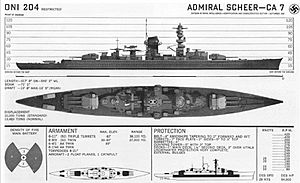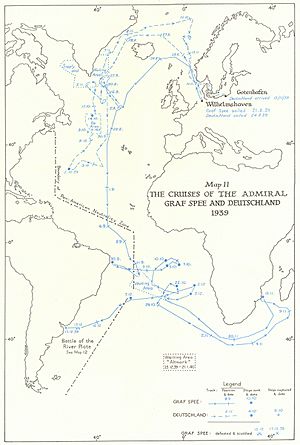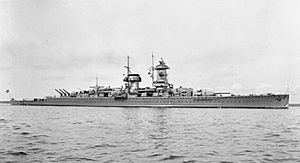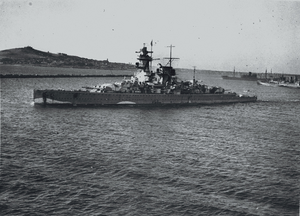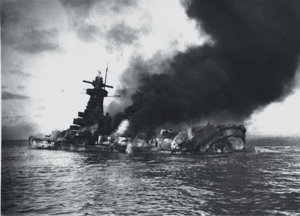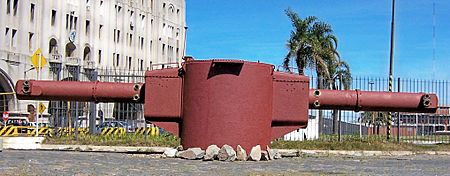German cruiser Admiral Graf Spee facts for kids
class="infobox " style="float: right; clear: right; width: 315px; border-spacing: 2px; text-align: left; font-size: 90%;"
| colspan="2" style="text-align: center; font-size: 90%; line-height: 1.5em;" | 
|} The Admiral Graf Spee was a special type of warship called a "Panzerschiff" (armored ship). The British Navy nicknamed it a "pocket battleship" because it was smaller than a battleship but carried very powerful guns. This ship served in the German Navy (called the Kriegsmarine) during World War II.
The ship was named after Admiral Maximilian von Spee, a hero from World War I. He led the German East Asia Squadron and fought in battles like Coronel and the Falkland Islands, where he sadly died. The Admiral Graf Spee was built in Wilhelmshaven, Germany. Its construction started in October 1932 and it was finished by January 1936.
Even though it was officially supposed to be under a certain size limit set by the Treaty of Versailles after World War I, the Admiral Graf Spee was actually much heavier. It had six large 28 cm guns in two turrets. This design meant it could outgun any cruiser that was fast enough to catch it. Its top speed of 28 knots (52 km/h; 32 mph) (knots) also meant that only a few very large and powerful enemy ships could catch and sink it.
Before World War II, the ship went on five patrols during the Spanish Civil War from 1936 to 1938. It also took part in a special event for King George VI in May 1937. In the weeks before World War II started, the Admiral Graf Spee was sent to the South Atlantic. Its job was to attack enemy merchant ships once the war began.
Between September and December 1939, the ship sank nine merchant vessels. But on December 13, it faced three British cruisers in the Battle of the River Plate. The Admiral Graf Spee caused a lot of damage to the British ships. However, it was also damaged and had to go to the port of Montevideo, Uruguay. The ship's commander, Hans Langsdorff, believed false reports that many more British warships were coming. So, he decided to sink his own ship (called scuttling) on December 17, 1939. Parts of the ship remained visible above the water for some time.
Contents
| History | |
|---|---|
| Name | Admiral Graf Spee |
| Namesake | Maximilian von Spee |
| Builder | Reichsmarinewerft, Wilhelmshaven |
| Laid down | 1 October 1932 |
| Launched | 30 June 1934 |
| Commissioned | 6 January 1936 |
| Fate | Scuttled, 17 December 1939 |
| General characteristics | |
| Class and type | Deutschland-class cruiser |
| Displacement | |
| Length | 186 m (610 ft 3 in) |
| Beam | 21.65 m (71 ft) |
| Draft | 7.34 m (24 ft 1 in) |
| Installed power | 54,000 PS (53,260 shp; 39,720 kW) |
| Propulsion | 2 propellers; 8 × diesel engines |
| Speed | 28.5 knots (52.8 km/h; 32.8 mph) |
| Range | 16,300 nautical miles (30,200 km; 18,800 mi) at 18.69 knots (34.61 km/h; 21.51 mph) |
| Complement |
|
| Sensors and processing systems |
|
| Armament |
|
| Armor |
|
| Aircraft carried | 1 × Heinkel He 60 floatplane |
| Aviation facilities | 1 × catapult |
Ship Design and Features
The Admiral Graf Spee was 186 meters (610 ft) long and 21.65 metres (71 ft) wide. When fully loaded, it weighed about 16,020 long tons (16,280 t). The ship was powered by four large diesel engines, which gave it a top speed of 28.5 knots (52.8 km/h; 32.8 mph). It could travel for a very long distance, about 16,300 nautical miles (30,200 km; 18,800 mi), at a cruising speed.
The ship's crew usually had 33 officers and 586 enlisted sailors. Later, this number grew to over 900 sailors. The Admiral Graf Spee had a catapult to launch one floatplane. At first, it carried a Heinkel He 60 plane, but this was later changed to an Arado Ar 196 before the war. This ship was also the first German warship to have radar, which helped it detect other ships.
Powerful Weapons
The main guns of the Admiral Graf Spee were six 28 cm (11 in) guns. These were placed in two large turrets, one at the front and one at the back of the ship. It also had eight smaller 15 cm (5.9 in) guns in single turrets along its sides.
For defense against aircraft, it had anti-aircraft guns. These were updated over time. By 1938, it had six 10.5 cm (4.1 in) guns, four 3.7 cm (1.5 in) guns, and ten 2 cm (0.79 in) guns. The ship also carried eight 53.3 centimetres (21 in) torpedo tubes at its back.
Strong Armor
The Admiral Graf Spee had strong armor to protect it in battle. Its main armored belt was 100 mm (3.9 in) thick. The main deck, where most of the important parts of the ship were, had armor between 45 to 70 mm (1.8 to 2.8 in) thick. The turrets holding the main guns had 140 mm (5.5 in) thick armor on their front.
Ship's History
The Admiral Graf Spee was built to replace an older battleship. Its construction began on October 1, 1932. It was launched on June 30, 1934, and a daughter of Admiral Maximilian von Spee christened it. The ship officially joined the German fleet on January 6, 1936.
For the first few months, the ship went through many tests to make sure it was ready for service. Its first commander was Conrad Patzig, who was later replaced by Walter Warzecha in 1937. The Admiral Graf Spee became the flagship of the German Navy, meaning it was the most important ship in the fleet.
In the summer of 1936, the ship was sent to the Atlantic Ocean. It took part in patrols during the Spanish Civil War to make sure no outside countries interfered. It did three such patrols between August 1936 and May 1937. On its way back from Spain, the Admiral Graf Spee visited Great Britain. It represented Germany in a special naval review for King George VI on May 20, 1937.
After this, it went back to Spain for another patrol. In 1938, Hans Langsdorff became the ship's commander. The ship then made several friendly visits to foreign ports, including Tangier and Lisbon. It also took part in large naval exercises in Germany. On August 21, 1939, just before World War II began, the Admiral Graf Spee left Wilhelmshaven and headed for the South Atlantic.
World War II Begins
When World War II started in September 1939, Adolf Hitler ordered the German Navy to begin attacking Allied merchant ships. The Admiral Graf Spee was told to follow strict rules: it had to stop and search ships for illegal goods before sinking them, and it had to make sure all the crews were safely off the ship. Commander Langsdorff was also ordered to avoid fighting other warships and to change his location often.
On September 1, the cruiser met its supply ship, the Altmark, near the Canary Islands. While refueling, Langsdorff moved extra equipment from the Admiral Graf Spee to the Altmark, including some of its anti-aircraft guns.
On September 11, the ship's floatplane spotted a British cruiser, the HMS Cumberland. Langsdorff quickly ordered both German ships to leave at high speed, and they successfully escaped. On September 26, the Admiral Graf Spee finally received orders to start attacking Allied merchant ships.
Four days later, its plane found the cargo ship Clement off Brazil. The Clement sent out a distress signal before the cruiser stopped it. The Admiral Graf Spee took the Clement's captain and chief engineer prisoner, but let the rest of the crew get into lifeboats. The cruiser then sank the Clement with its guns and torpedoes. Langsdorff even sent a distress signal to a nearby naval station to make sure the crew was rescued. This made the British Navy warn all their merchant ships that a German raider was in the area.
On October 5, the British and French navies formed eight groups to hunt down the Admiral Graf Spee. These groups included aircraft carriers, battleships, and many cruisers. One group, called Force G, was led by Commodore Henry Harwood and included the cruisers Cumberland and Exeter. This group was later joined by two light cruisers, Ajax and Achilles.
The Admiral Graf Spee continued its attacks. It captured the steamer Newton Beech and sank the merchant ship Ashlea. It also sank the Newton Beech after transferring its prisoners to the cruiser. On October 10, it captured the steamer Huntsman. Since it couldn't hold all the prisoners, the Huntsman was sent to meet the Altmark. On October 15, the Admiral Graf Spee met the Altmark to refuel and transfer prisoners. The next day, the Huntsman joined them. All prisoners were moved to the Altmark, and the Huntsman was sunk on October 17.
On October 22, the Admiral Graf Spee sank the steamer Trevanion. At the end of October, Langsdorff sailed his ship into the Indian Ocean. This was a trick to make the Allies think he was somewhere else and to draw their warships away from the South Atlantic. By this time, the Admiral Graf Spee had traveled almost 30,000 nautical miles (56,000 km; 35,000 mi) and needed engine maintenance.
On November 15, the ship sank the tanker MV Africa Shell. The next day, it stopped a Dutch ship but did not sink it. The Admiral Graf Spee returned to the Atlantic between November 17 and 26 to refuel from the Altmark. During this time, the crew built a fake gun turret on the ship's bridge and a fake second funnel to change its appearance. This was meant to confuse Allied ships about its true identity.
The Admiral Graf Spee's floatplane found the merchant ship Doric Star. Langsdorff fired a warning shot to stop the ship. The Doric Star managed to send a distress signal before it was sunk. This signal made Commodore Harwood take his three cruisers to the mouth of the River Plate, as he suspected this might be Langsdorff's next target.
On December 3, the Admiral Graf Spee sank the steamer SS Tairoa. On December 6, it met the Altmark again and transferred 140 prisoners. The Admiral Graf Spee found its last victim on December 7, the freighter Streonshalh. From this ship, the Germans found secret documents with shipping route information. Based on this, Langsdorff decided to head for the seas off Montevideo. On December 12, the ship's Arado 196 plane broke down and couldn't be fixed, so the Admiral Graf Spee lost its aerial scouting ability. The ship's disguise was also removed, so it wouldn't get in the way during a battle.
The Battle of the River Plate
At 5:30 AM on December 13, 1939, lookouts on the Admiral Graf Spee spotted two masts. Langsdorff thought it was an escort for a convoy. But at 5:52 AM, the ship was identified as Exeter, along with two smaller warships, which were quickly identified as light cruisers. Langsdorff decided to fight instead of running away. He ordered his ship to battle stations and to close in fast.
At 6:08 AM, the British ships spotted the Admiral Graf Spee. Harwood split his ships to make it harder for the German ship to target them with its powerful 28 cm guns. The German ship opened fire with its main guns on Exeter and its smaller guns on the flagship Ajax at 6:17 AM. Exeter fired back at 6:20 AM, followed by Ajax at 6:21 AM and Achilles at 6:24 AM.
In just thirty minutes, the Admiral Graf Spee hit Exeter three times. These hits disabled two of its gun turrets, destroyed its bridge and aircraft catapult, and started big fires. Ajax and Achilles moved closer to the Admiral Graf Spee to help Exeter.
Langsdorff thought the two light cruisers were launching a torpedo attack, so he turned away behind a smokescreen. This break allowed Exeter to leave the fight. By then, only one of its gun turrets was working, and it had suffered many casualties. Around 7:00 AM, Exeter returned to the battle, firing from its last working turret. The Admiral Graf Spee fired back, hitting Exeter again and forcing it to leave the battle for good.
At 7:25 AM, the Admiral Graf Spee hit Ajax, disabling its rear turrets. Both sides then stopped fighting. The Admiral Graf Spee retreated into the River Plate estuary, while Harwood's damaged cruisers stayed outside to watch. During the battle, the Admiral Graf Spee was hit about 70 times. 36 men were killed and 60 were wounded, including Langsdorff himself.
The Scuttling of the Ship
Because of the damage and casualties, Langsdorff decided to go into Montevideo port. Here, repairs could be made, and the wounded could be taken to hospitals. Most of the hits from the British cruisers caused only minor damage. However, the oil purification plant, which was vital for the engines, was destroyed. The ship's water purification system and kitchen were also ruined, which would have made a return journey to Germany very difficult. A hit in the front of the ship would also have made it hard to sail in rough seas. The Admiral Graf Spee had also used up most of its ammunition during the battle.
After arriving in port, the wounded crew members went to local hospitals, and the dead were buried with full military honors. The captured Allied sailors, including captains and engineers, were released. Repairs to make the ship seaworthy were expected to take about two weeks.
British naval intelligence tried to trick Langsdorff into believing that a much stronger British force was gathering to destroy his ship if he tried to leave the harbor. The British sent out fake radio signals that they knew German intelligence would intercept. In reality, the closest large British warships were very far away. Believing the British reports, Langsdorff discussed his choices with commanders in Germany. He could try to escape and seek safety in Buenos Aires, Argentina, where the ship would be held for the rest of the war. Or, he could sink the ship in the River Plate estuary.
Langsdorff did not want to risk the lives of his crew. He decided to sink the ship. He knew that even though Uruguay was neutral, its government was friendly with Britain. If he allowed his ship to be held, British intelligence officers would get access to the ship. Under international rules, the Admiral Graf Spee could only stay in Montevideo for 72 hours for repairs before it would be held for the rest of the war.
On December 17, 1939, Langsdorff ordered all important equipment on the ship to be destroyed. The remaining ammunition was spread throughout the ship to help sink it. That evening, the ship, with only Langsdorff and 40 other men, moved into the outer harbor. A crowd of 20,000 people watched as the charges were set. The crew left the ship on an Argentine tugboat, and the ship was scuttled at 8:55 PM. Many explosions sent flames high into the air and created a huge smoke cloud. The ship burned in the shallow water for the next two days.
On December 20, Langsdorff died in his hotel room in Buenos Aires. In January 1940, the neutral American cruiser USS Helena visited Montevideo. Its crew was allowed to see the wreck of the Admiral Graf Spee. The American sailors also met the German crew members, who were still in Montevideo. After the scuttling, the ship's crew were taken to Argentina, where they remained for the rest of the war.
The Wreck of the Ship
The wreck of the Admiral Graf Spee was partly broken up in 1942–1943. However, parts of the ship were still visible for some time. The wreck lies in water only 11 m (36 ft) deep. A company from Montevideo bought the rights to salvage the wreck from the German Government for £14,000. This company was actually a front for the British. The British were surprised by how accurate the German ship's guns were. They hoped to find a radar rangefinder, which they did. They used this information to develop ways to counter German radar.
In February 2004, a team began working to raise parts of the Admiral Graf Spee wreck. The government of Uruguay and private companies helped pay for this operation. The wreck was a danger to ships in the area. The first large piece, a 27 metric tons (27 long tons; 30 short tons) gunnery rangefinder, was brought up on February 25.
On February 10, 2006, a two-metre (6 ft 7 in), 400-kilogram (880 lb) eagle and swastika crest was recovered from the back of the ship. It was stored in a Uruguayan naval warehouse. This was done after Germany complained about displaying "Nazi symbols." An attempt to sell the ornament led the Uruguayan government to ban any sale. This was to prevent neo-Nazis from getting it. Instead, the Uruguayan Navy kept it in storage.
A court case about the private salvage company involved in raising the wreck ended in 2019. The court ordered the government to sell the ornament and give some money to the salvage company. However, this decision was later overturned, and the government got full control of the crest. On January 2, 2022, a newspaper reported that an Argentine businessman, Daniel Sielecki, offered to buy the eagle and swastika crest. Sielecki said he wanted to break the crest into “a thousand pieces” to keep it out of the hands of neo-Nazis.
On June 17, 2023, the New York Times reported that the eagle and crest would be melted down and turned into a dove by a Uruguayan artist. However, the next day, Uruguayan president Luis Lacalle Pou stopped the plan. He said that "there is an overwhelming majority that does not share this decision" and that "if one wants to generate peace, the first thing one has to do is to generate union. Clearly this has not generated it."
See also
- The Battle of the River Plate (film) (also called Pursuit of the Graf Spee in the US) is a 1956 British war film about the battle.


